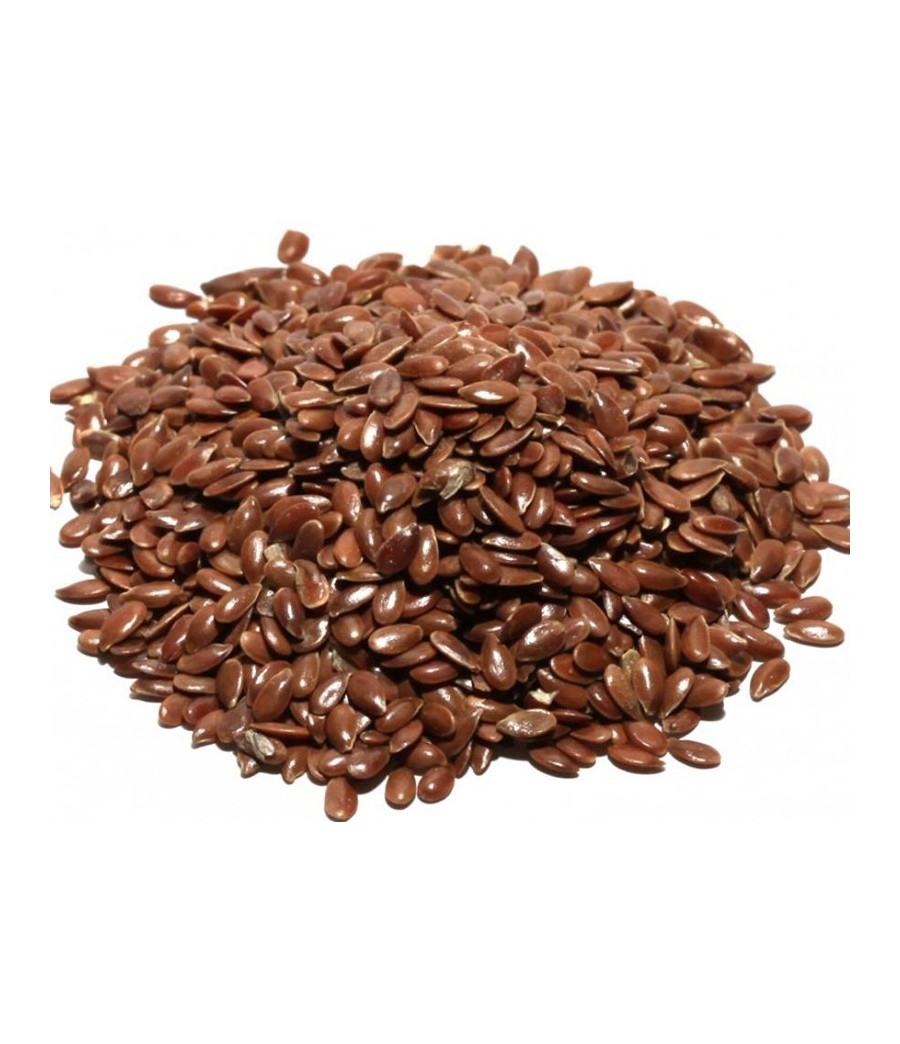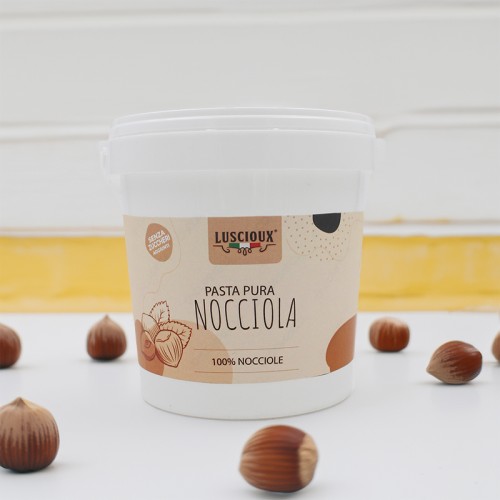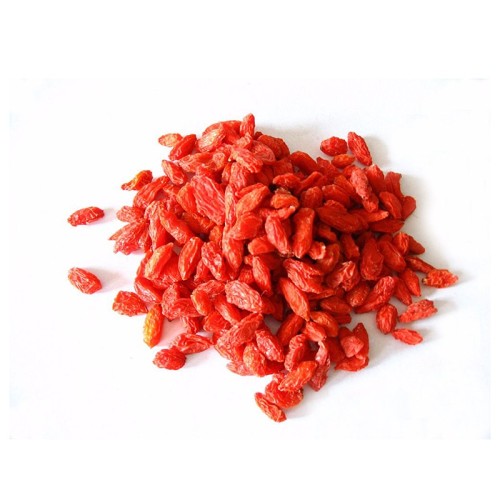Brown Flax Seeds
(€4.55 Per Kg)
 Security policy
Security policy
Transparency and reliability - Encrypted information (SSL Certificate)
 Delivery policy
Delivery policy
Fast shipping with delivery in 1- 4 working days.
 Return policy
Return policy
24/7
Flax is a tasteless seed, which is why it does not possess particular culinary qualities; it is certainly most appreciated for its healing properties. Like most oil seeds, flax seeds are perfect for adding to salads or granola.
Specific References
- ean13
- 8054134416642
Nutritional values
| Ingredients | Ingredients: Flaxseed from organic farming. May contain traces of PEANUTS and NUTS. | 1kg |
| Method of conservation | Keep in a cold and dry place. | |
| Nutrition declaration | average values per 100 g: | |
| Power | 2123kJ / 515kcal | |
| Fats | 41 g | |
| of which saturated fatty acids | 4.6g | |
| Carbohydrates | 2.4g | |
| of which sugars | 1.9g | |
| Fibers | 26 g | |
| Protein | 21 g | |
| Salt | 0.11 g | |
| Phosphorus | 604 mg (86% NRV*) | |
| Copper | 1.5mg (150% NRV*) | |
| Manganese | 2.4 mg (120% NRV*) | |
| Source | Euro Company analysis | |
| Directions | The advice given IS NOT IN ANY WAY TO BE CONSIDERED OF MEDICAL/PRESCRIPTIVE VALUE. The information provided is for informational and informative purposes only, therefore they are not intended in any way to replace medical advice. In the presence of pathologies you should always consult your doctor. | |
| Origin | India | |
| Nutrients | Phosphorus, Manganese, Copper | |
| Vnr | *Nutritional Reference Value | |
| Label and packaging | The images are included for illustrative purposes, the product may undergo changes based on stock availability and the selected weight. |
Curiosity
Thelinen (Linumusitatissimum)Is an annual plant of the familyLinaceae, with a vegetative cycle of about four months and easily cultivated in temperate climate regions.
The flax plant grows to a height of 1.2 m with a slender stem and tender, lanceolate leaves and sky-blue flowers 15-25 mm in diameter with 5 petals. The fruits are round capsules containing small seeds of a brown or yellow/gold colour, shiny, similar to the seeds of apples, 4-7 mm long.
The flax is harvested after about 100 days, or one month after flowering and two weeks after the formation of the seed pods. The base of the plant should start to turn yellow, as if the plant is still green, the seeds and fibers (for the textile market) will not be properly developed.
The collection of the seeds can take place by cutting the whole plant or just the head. There will then be drying in order to extract the seeds.
The seeds - rich in long-chain fatty acids - can be eaten whole and dried, or soaked in water and eaten as soon as they sprout. Wet seeds become slightly slimy, but this does not affect their nutritional properties.
The main food products that are obtained fromflax seedThey are the flour and the oil.
The best fiber production is obtained in cold countries: Russia, the Netherlands, France and Romania are among the world's leading fiber producers. Flax fibers are two to three times stronger than cotton, plus they are naturally smooth and straight. Europe and North America depended on the cultivation of flax for textile purposes until the 19th century, when cotton displaced flax.
In North India iflax seedThey are traditionally toasted, pulverized and eaten with boiled rice, a little water and salt.
Flax is the emblem of Northern Ireland and the national flower of Belarus.
In early versions of the Sleeping Beauty tale, as in “Sun, Moon andThalia” by Giambattista Basile, the princess pricks her finger not on a spindle, but with a splinter of linen which is then extracted by her newborn children, conceived while she is magically asleep.
Sources:
History
The first evidence of man's use of flax as a textile fiber comes from Georgia, where spun, colored and knotted wild flax fibers were found in the Dzudzuana cave and dated up to 32,000 years ago.
Flax was first grown in the Fertile Crescent region. There is evidence of oil flax with larger seeds from the TellRamad site in Syria, dated 9,000 years ago.
The use of cultivation has expanded steadily, reaching places as far away as Switzerland and Germany in 3000 BC
Domestic flax has also been cultivated in China and India for at least 5,000 years.
Flax was grown extensively in ancient Egypt, where temple walls were painted with flax flowers and mummies were wrapped in linen. Egyptian priests wore only linen, considered a symbol of purity.
The Phoenicians traded Egyptian flax throughout the Mediterranean and the Romans used it for their sails. The decline of the Roman Empire brings with it the decline of flax production, but Charlemagne restores light to this crop in the XIII century, with laws designed to publicize the hygiene of textile fibers in flax and the wholesomeness of seed oil of linen.
In time Flanders became the major center of the linen industry in the Middle Ages.
In North America, flax was introduced by the colonialists and prospered, but in the early 20th century, cotton, being the advance of farms and cheaper cotton, led to the centralization of flax cultivation in northern Russia, where it has 90% of world production.
In Italy, the territory of today's town of Linera, in the province of Catania, was used for the cultivation of flax and from it the district was indicated, in fact, the "linerie". With the foundation of the inhabited nucleus, which took place at the beginning of the 19th century, the town took on its current name in memory of these ancient crops.
Flax seeds have received attention for the anti-inflammatory and antioxidant capacity that has been attributed to them. A 2015 study conducted in São Paulo (Brazil), hypothesized that adding flaxseed to a diet designed to achieve weight loss could promote lipid and metabolic profiles and decrease the risk of factors related to cardiovascular disease .
In the study 27 volunteers with cardiovascular risk factors were divided into two groups and, following a low carbohydrate diet for 42 days, they integrated 60g per day of either brown rice powder or flaxseed powder. Blood pressure, anthropometric values and serum levels of glucose, uric acid, insulin and others were checked.
Both groups experienced weight loss and reduction in systolic blood pressure during the study; improvement in total cholesterol, LDL cholesterol and uric acid levels. A reduction in inflammatory markers and triglyceride levels was observed in the flaxseed group.
The results of the study suggest that the addition of flaxseed to a diet designed for weight loss may be an important nutritional strategy for reducing inflammatory markers 1 .
Magnesium among its many benefits, contributes to the reduction of tiredness and fatigue, healthy muscle function and psychological function. Helps electrolyte balance and protein synthesis; intervenes in the process of cell division 2 .
Phosphorus contributes to normal energy-yielding metabolism, the normal function of cell membranes and the maintenance of normal bones and teeth 2 .
Copper has multiple activities: it contributes to normal energy metabolism, to the maintenance of normal connective tissues and to the normal functioning of the nervous system . It contributes to normal skin and hair pigmentation, to normal iron transport in the body, to the normal function of the immune system and to the protection of cells from oxidative stress 2 .
Thiamine contributes to normal energy-yielding metabolism, normal functioning of the nervous system and contributes to normal psychological and cardiac function 2 .
ALA contributes to the maintenance of normal blood cholesterol levels 2 .
1 Cassani RS, Fassini PG1, Silvah JH, Lima CM, Marchini JS. Impact of weightlossdietassociated with flaxseed on inflammatorymarkers in men with cardiovascular risk factors: a clinicalstudy. Nutr J. 2015 Jan10;14:5.
2 Regulation (EU) no. 432/2012 of the Commission, of 16 May 2012 - concerning the compilation of a list of permitted health claims on food products, other than those referring to the reduction of disease risk and to children's development and health.
Sources :
storage
You can store flax seeds in cool, dry places away from heat and humidity. Here are 4 useful tips:
- The ideal condition for keeping flax seeds is in a refrigerated environment. Flax seeds can also be stored without problems at room temperature during the winter season given the low temperatures. During the summer, on the other hand, it is advisable to keep it in the fridge or in the coolest possible places, as the increase in temperatures could favor the deterioration of the products.
- The ideal container in which to store flax seeds is glass. In fact, thanks to its constitution it is impenetrable to chemical and gaseous agents, and having excellent thermal insulating capacity it maintains the initial temperature for a longer time compared to other materials. If the glass is colored, all the better: using colored glass prevents the entry of some wavelengths of light (including ultraviolet light) and therefore some nutritional and organoleptic characteristics remain unaltered.
- The type of closure of the container is also important: an airtight cap ensures that the food is protected from excessive contact with oxygen which can lead to lipid oxidation and which can be essential for aerobic bacteria.
- The environment should always be well ventilated: by ventilating the rooms, the internal humidity that escapes from the window is kept under control, guaranteeing the right balance, which helps to discourage the onset of mould.
Flax seeds should be eaten raw, because heat risks altering their nutritional characteristics, reducing the absorption of vitamins and fatty acids. You can add them to milk or smoothies or over fruit.
Property
100g of flax seeds contain:
- 604 mg of Phosphorus , equal to 86% of the NRV (Nutrient Reference Value)
- 1.5 mg of Copper , equal to 150% of the NRV;
- 2.4 mg of Manganese , equal to 120% of the NRV.
No customer reviews for the moment.






